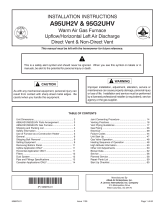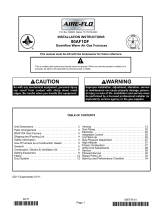Page is loading ...

Page 1
507984-02
01/2021
Supersedes 507984-01
INSTALLATION INSTRUCTIONS FOR NATURAL TO REGULATED LP/PROPANE
GAS CHANGEOVER KIT (19D58) FOR ML180UHV GAS FURNACES
GAS CHANGEOVER KIT
GAS UNITS
KITS & ACCESSORIES
WARNING
This conversion kit is to be installed by a licensed
professional service technician (or equivalent)
or other qualied agency in accordance with
the manufacturer’s instructions, all codes and
requirements of the authority having jurisdiction in
the USA. If the information in these instructions is
not followed exactly, a re or explosion may result
causing property damage, personal injury or loss
of life. The qualied agency performing this work
assumes responsibility for this conversion.
WARNING
Danger of explosion.
There are circumstances in which odorant used with
LP/propane gas can lose its scent. In case of a leak,
LP/propane gas will settle close to the oor and may
be dicult to smell. An LP/propane leak detector
should be installed in all LP applications.
Shipping and Packing List
Package 1 of 1 contains:
2 - LP/Propane regulator springs (77W89)
10 -Main burner orices (0.034)
1 - Gas converter sticker
1 - Nameplate conversion sticker
1 - Low gas inlet pressure switch (S145)
1 - Gas valve inlet tting
1 - Wire harness
Application
Use natural to LP gas conversion kit 19D58 to convert
ML180UHV gas furnaces from natural gas to regulated
LP/Propane.
Installation
CAUTION
As with any mechanical equipment, contact with
sharp sheet metal edges can result in personal
injury. Take care while handling this equipment and
wear gloves and protective clothing.
1 - Set the thermostat to the lowest setting. Shut o the
gas supply to the furnace, then turn o the electrical
power at the unit disconnect switch.
2 - Remove the access panel. Move the automatic gas
valve switch to OFF. See gure 6.
3 - Disconnect the gas supply from the gas valve.
Disconnect the wiring harness at the gas valve.
4 - Remove the four manifold securing screws. Remove
the manifold/gas valve assembly. Replace the main
burner orices with the provided orices. Torque to
approximately 35 in-lbs. See gure 3.
IMPORTANT
DO NOT use pipe dope or any pipe sealant on gas
orice threads.
5 - Gas Valve Conversion
a - Remove both high re and low re springs from the
gas valve. See gure 5.
b - Replace both high re and low re springs with the
provided LP springs color-coded white.
c - Install the high re adjustment screw and adjust
approximately 12 turns.
d - Install the low re adjustment screw and adjust
approximately 8 turns.
e - Install both regulator screw covers.
6 - Re-install the manifold/valve assembly.
7 - Thread provided tting to gas valve inlet until hand
tight. Using properly sized wrench, tighten tting
2 to 3 full turns being careful to position the side
port to allow clearance for the pressure switch and
harness. See gures 1 or 2.
NOTE - Step 5 is for gas valve conversion only. Unit
manifold pressure must be checked as shown on
page 3.
IMPORTANT
Carefully check all piping connections at the valve
for gas leaks. DO NOT use matches, candles, open
ames or other means of ignition to check for gas
leaks. Use a soap solution or other preferred means.
©2021

Page 2
8 - Thread the gas supply to the tting until hand tight.
A eld provided coupling may be needed. See
gure 2. Using properly sized wrench to support
tting, tighten supply line into tting 2 to 3 full turns
to achieve leak free joint.
NOTE - Do not over tighten. (Maximum 3 full turns
past hand tight for ½” NPT per ASME B1.20.1-2013)
9 - Thread pressure switch (S145) to tting 2 to 3 turns
past hand tight, then wire as shown in gure 4.
10 - Restore the electrical power to the unit.
11 - Inspect all sides of assembly. Turn on gas supply.
Immediately check the entire tting surface and
assembly joints for gas leaks.
12 - Ax nameplate conversion sticker next to unit
nameplate.
13 - Complete the information required on the gas
converter sticker: date, name, and address. Ax
sticker to the exterior of the unit in a visible area.
14 - Follow the steps given in the start-up and adjustment
section.
CAUTION
Some soaps used for leak detection are corrosive
to certain metals. Carefully rinse piping thoroughly
after leak test has been completed
after leak test has been completed
Low Inlet Pressure
Switch (S145)
Brass Fitting
GAS VALVE WITH LOW INLET
PRESSURE SWITCH
Figure 1
SWITCH (S145) LOCATION
Fitting
Low Inlet Pressure
Switch (S145)
GAS VAVE WITH LOW INLET PRESSURE
Install field
provided
coupling
Figure 2
ML180UHV BURNER BOX
ASSEMBLY SHOWN
Manifold And
Gas Valve
Sensor
Rollout Switches
Figure 3
LOW INLET PRESSURE SWITCH (S145) WIRING
GAS VALVE
NO
C
WHITE
ORANGE
LOW INLET
PRESSURE
SWITCH
BROWN
ORANGE
PROVIDED HARNESS WIRES
Point-to-Point Wiring Diagram
Schematic Diagram
YELLOW
Figure 4
High Low
Regulator
Cover Screw
Plastic Regulator
Adjustment Screw
Regulator Spring
Figure 5

Page 3
Start-Up & Adjustment
BEFORE PLACING THE UNIT INTO OPERATION -
Smell all around the appliance area for gas. Be sure to
smell next to the oor because LP/Propane gas is heavier
than air and will settle on the oor. Use only your hand to
move the gas control switch. Never use tools. If the switch
will not move by hand, do not try to repair it. Force or at-
tempted repair may result in a re or explosion.
A - Placing the Unit into Operation
Follow the lighting instructions provided on the unit.
If lighting instructions are not available, refer to the
following section.
Units are equipped with a two-stage integrated ignition
system. The integrated ignition control automatically lights
the burners each time the thermostat calls for heat.
1 - STOP! Read the safety information at the beginning
of this section.
2 - Set the thermostat to its lowest setting.
3 - Turn o all electrical power to the furnace.
4 - Do not try to light the burners by hand.
5 - Remove the unit access panel.
6 - Move the switch on the gas valve to OFF. Do not
force the switch. See gure 6.
GAS VALVE SHOWN IN OFF POSITION
INLET PRESSURE
POST
HIGH FIRE ADJUSTMENT
SCREW (under cap)
MANIFOLD PRESSURE
POST
WHITE RODGERS GAS VALVE
LOW FIRE
ADJUSTMENT
SCREW
(under cap)
Figure 6
7 - Wait ve (5) minutes for any gas to clear out. If you
then smell gas, STOP! Immediately call your gas
supplier from a neighbor’s phone. Follow the gas
supplier’s instructions. If you do not smell gas, go
to the next step.
8 - Move the switch on the gas valve to ON.
9 - Replace the unit compartment access panel.
10 - Turn on all electrical power to the unit.
11 - Set the thermostat to desired setting.
12 - If the furnace will not operate, see section E- “Turning
Gas O to the Unit” and call the gas supplier.
Gas Pressure Measurement
A - Supply Pressure Measurement
An inlet pressure post located on the gas valve provides
access to the supply pressure. See gure 6. Back out the
3/32 hex screw one turn, connect a piece of 5/16 tubing
and connect to a manometer to measure supply pressure.
Check the unit on high re. On multiple unit installations,
check the unit separately and with the other units oper-
ating. See table 1 for supply line pressure. Following the
supply pressure check, turn o unit, remove manometer
and tighten post hex screw.
B - Measuring & Adjusting the Manifold Pressure
NOTE - Pressure test adapter kit (10L34) is available from
Lennox to facilitate manifold pressure measurement.
A manifold pressure post located on the gas valve pro-
vides access to the manifold pressure. See gure 6. Back
out the 3/32 hex screw one turn, connect a piece of 5/16
tubing and connect to a manometer to measure manifold
pressure.
1 - Connect test gauge to manifold pressure post
(gure 6) on gas valve.
2 - Ignite unit on low re and let run for 5 minutes to
allow for steady state conditions.
3 - After allowing unit to stabilize for 5 minutes, record
manifold pressure and compare to value given in
table 1.
4 - If necessary, make adjustments. Figure 6 shows
location of high re and low re adjustment screws.
5 - Repeat steps 2, 3 and 4 on high re. See values in
table 1.
6 - Shut unit o and remove manometer as soon as an
accurate reading has been obtained. Take care to
replace pressure tap plug.
7 - Start unit and perform leak check. Seal leaks if
found.
TABLE 1
Manifold Pressure in.wg. Gas Line Pressure in.wg.
Low Fire High Fire Min Max
4.9 10.0 11.0 13.0
C - Gas Flow (Approximate)
NOTE - To obtain accurate reading, shut o all other gas
appliances connected to meter.
Furnace should operate at least 5 minutes before check-
ing gas ow. Determine time in seconds for two revolu-
tions of gas through the meter. (Two revolutions assures
a more accurate time.) Divide by two and compare to
time in table 2 below. If manifold pressure matches table
1 and rate is incorrect, check gas orices for proper size
and restriction. Remove temporary gas meter if installed.

Page 4
TABLE 2
GAS METER CLOCKING CHART
Unit Capacity
Seconds for One Revolution
LP/Propane
1 cu ft Dial 2 cu ft DIAL
-045 200 400
-070 136 272
-090 102 204
-110 82 164
2500 btu/cu ft
D- Proper Combustion
Furnace should operate minimum 15 minutes with correct
manifold pressure and gas ow rate before checking com-
bustion. Take combustion sample beyond the ue outlet.
See table 3.
NOTE - Shut unit o and remove manometer as soon as
supply line pressure, manifold pressure and combustion
sample have been obtained. Take care to replace pres-
sure tap plug.
TABLE 3
ML180V Firing Rate CO2% For L.P.
All Models High Fire 7.5 - 9.0
Low Fire 5.0 - 6.0
The carbon monoxide reading should not exceed 100 ppm.
E- Turning O Gas To The Unit
1 - Set the thermostat to its lowest setting.
2 - Turn o all the electrical power to the unit.
3 - Remove the unit access panel.
4 - Move the switch on the gas valve to OFF. Do not
force the switch.
/

